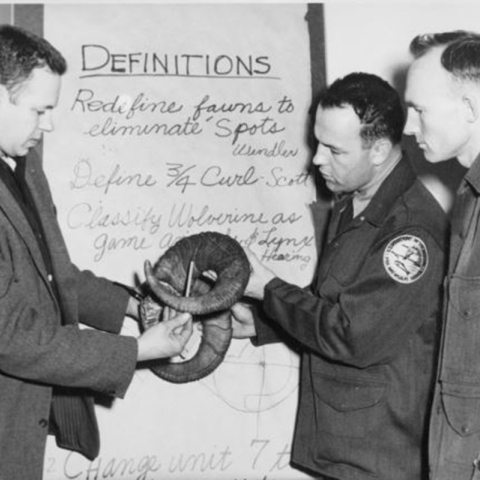
About Stanley S. Fredericksen (1924-1958)
Photo above: Biologist Robert Scott discusses the annual growth rings of the Dall Sheep with Game Management Agents Ray Tremblay and Stanley Fredericksen. Photographed by J. Malcolm Greany.
Biography
Stanley Stewart Fredericksen was born on July 4, 1924, in West Yellowstone, Montana. He was the second of eight children, and he graduated from Idaho Falls High School in 1943 before entering the U.S. Army Air Corps and receiving training as a pilot and radio operator. After his discharge from the military in 1946, Fredericksen joined the Idaho Fish and Game Department and attended the Spartan School of Aeronautics in Tulsa, Oklahoma. Fredericksen married Betty Ann Dowling on October 6, 1948, and they had two children: Rick and Teresa Ann. A few years later, Fredericksen was recalled for military service during the Korean War, interrupting his time at the Idaho Fish and Game Department. He served as a U.S. Air Force air-sea rescue pilot in Okinawa until the end of the Korean War, and afterwards, he returned to the Idaho Fish and Game Department for a brief time. In 1953, Fredericksen moved to Alaska and joined the U.S. Fish and Wildlife Service (Service). He served as a game management agent for the Regional Office of Alaska, specifically overseeing the Fairbanks District in Juneau, Anchorage, and Fairbanks. Fredericksen also received commendations for his scenic photography.
Cause of Death
On August 21, 1958, Fredericksen was killed in the crash of a Grumman Goose, an amphibious flying boat, in the Philip Smith Mountains of the Eastern Brooks Range. He was part of a round-trip mission from Porcupine Lake to Fairbanks to look over the Arctic wildlife area, count Dall sheep, and establish a gas cache. Fredericksen was accompanied by Clarence J. Rhode, Regional Director of the Service in Alaska, and Rhode’s eldest son, Jack. The flight was ultimately reported overdue, and a search was initiated. Their disappearance resulted in one of the largest air and ground searches in Alaska history, extending from the time of the incident to December 1958. However, it was not until August 23, 1979, that their story reached closure. Two hikers found the wreckage in a steep, craggy area almost 6,000 feet in elevation. An investigation into the wreckage indicated that the Grumman Goose likely hit a rock wall due to poor visibility in the high, narrow mountain pass, and this impact resulted in the onboard fuel exploding. The death of all three members of the flight was likely instantaneous. Posthumously, Fredericksen received the U.S. Department of the Interior’s Certificate of Honor for commendable service.
Sources
- Alaska Game Commision Juneau. “Caribou Management Studies.” Job Completion Reports,vol. 13, no. 3, 1 May 1959.
- Allen, David B. “Summary of accidental deaths of U.S. Fish and Wildlife Service employees in Alaska since 1958.” Received by Blake Sasse, 17 Feb. 1998.
- Davis, Joy. “Rhode Plane Wreckage in Alaska Found by Hikers After 21 Years.” U.S. Department of the Interior, 4 Sept. 1979.
- National Wildlife Refuge System. “A Look Back…Clarence Rhode.” Refuge Update, vol. 10, no. 6, Dec. 2013.
- U.S. Fish and Wildlife Service Museum and Archives files with content contributed by Rick Stewart Fredericksen, son of Stanley Fredericksen.
Key Fields
Born 1924, Died 1958, Age 34, Male, Game Management Agent, Regional Office of Alaska, Alaska, Plane, Crash, Certificate of Honor, Pilot, Army, Korean War